
Baja California Sur, officially Estado Libre y Soberano de Baja California Sur, is the least populated state and the 31st admitted state of the 32 federal entities which comprise the 31 States of Mexico. It is also the ninth-largest Mexican state in terms of area.
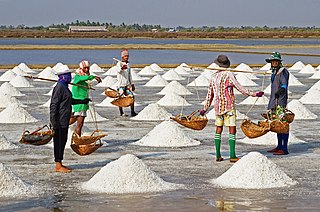
Sea salt is salt that is produced by the evaporation of seawater. It is used as a seasoning in foods, cooking, cosmetics and for preserving food. It is also called bay salt, solar salt, or simply salt. Like mined rock salt, production of sea salt has been dated to prehistoric times.

Mitsubishi Corporation is Japan's largest trading company and a member of the Mitsubishi keiretsu. As of 2022, Mitsubishi Corporation employs over 80,000 people and has ten business segments, including energy, industrial finance, banking, machinery, chemicals, and food.

Daniel Keith Ludwig was an American shipping businessman, who was also involved in many other industries. He pioneered the construction of super tankers in Japan, founded Exportadora de Sal, SA in Mexico and developed it as the largest salt company in the world, built a model community in association with the Jari project, which he pioneered, on the Amazon River in Brazil to produce pulp paper, and had numerous hotels around the world.
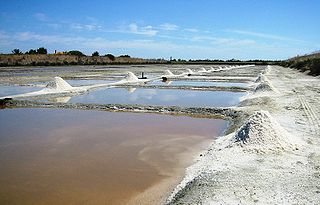
A salt evaporation pond is a shallow artificial salt pan designed to extract salts from sea water or other brines. The salt pans are shallow and expansive, allowing sunlight to penetrate and reach the seawater. Natural salt pans are formed through geological processes, where water evaporating, leaving behind salts deposits. Some salt evaporation ponds are only slightly modified from their natural version, such as the ponds on Great Inagua in the Bahamas, or the ponds in Jasiira, a few kilometres south of Mogadishu, where seawater is trapped and left to evaporate in the sun.

Salt, also referred to as table salt or by its chemical formula NaCl, is an ionic compound made of sodium and chloride ions. All life depends on its chemical properties to survive. It has been used by humans for thousands of years, from food preservation to seasoning. Salt's ability to preserve food was a founding contributor to the development of civilization. It helped eliminate dependence on seasonal availability of food, and made it possible to transport food over large distances. However, salt was often difficult to obtain, so it was a highly valued trade item, and was considered a form of currency by certain people. Many salt roads, such as the Via Salaria in Italy, had been established by the Bronze Age.

The Baja California desert is a desert ecoregion of Mexico's Baja California peninsula. This ecoregion occupies the western portion of the Baja California peninsula, and occupies most of the Mexican states of Baja California Sur and Baja California. It covers 77,700 square kilometers. The climate is dry, but its proximity of the Pacific Ocean provides humidity and moderates the temperature. The flora mostly consists of xeric shrubs and over 500 species of recorded vascular plants.

Briquetage or very coarse pottery (VCP) is a coarse ceramic material used to make evaporation vessels and supporting pillars used in extracting salt from brine or seawater. Thick-walled saltpans were filled with saltwater and heated from below until the water had boiled away and salt was left behind. Often, the bulk of the water would be allowed to evaporate in salterns before the concentrated brine was transferred to a smaller briquetage vessel for final reduction. Once only salt was left, the briquetage vessels would have to be broken to remove the valuable commodity for trade.
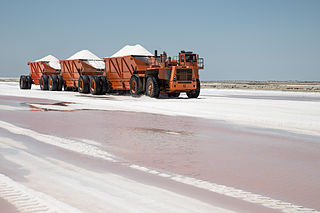
Guerrero Negro is the largest town located in the municipality of Mulegé in the Mexican state of Baja California Sur (BCS). It had a population of 13,596 in the 2020 census. The town is served by Guerrero Negro Airport.
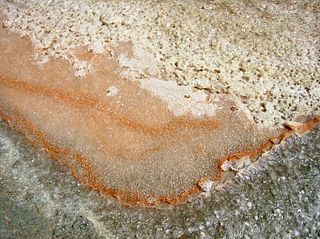
Fleur de sel or flor de sal is a salt that forms as a thin, delicate crust on the surface of seawater as it evaporates. Fleur de sel has been collected since ancient times, and was traditionally used as a purgative and salve. It is now used as a finishing salt to flavor and garnish food. The origin of the name is uncertain, but is perfectly in line with both meanings of fleur: the surface of something and its best part; the fact the salt crust also might form flower-like patterns of crystals might be of influence.

A saltern is an area or installation for making salt. Salterns include modern salt-making works (saltworks), as well as hypersaline waters that usually contain high concentrations of halophilic microorganisms, primarily haloarchaea but also other halophiles including algae and bacteria.

Open-pan salt making is a method of salt production wherein salt is extracted from brine using open pans.
Bittern, or nigari, is the salt solution formed when halite precipitates from seawater or brines. Bitterns contain magnesium, calcium, and potassium ions as well as chloride, sulfate, iodide, and other ions.

El Caracol Solar Evaporation Pond, also known as El Caracol de Texcoco or "El Caracol de la Ciudad de México, is a large spiral-shaped retention basin located over the former lakebed of Lake Texcoco, northeast of Mexico City, in the municipio of Ecatepec de Morelos, Mexico.

Hutt Lagoon is a marine salt lake located near the Indian Ocean coast 2 kilometres (1.2 mi) north of the mouth of the Hutt River, in the Mid West region of Western Australia.
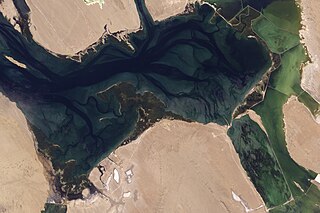
Ojo de Liebre Lagoon, translated into English as "hare eye lagoon", is a coastal lagoon located in Mulegé Municipality near the town of Guerrero Negro in the northwestern Baja California Sur state of Mexico. It lies approximately halfway between the southern tip of the Baja California Peninsula and the U.S.-Mexico border, opening onto the Pacific Ocean.

Charles Melville Scammon (1825–1911) was a 19th-century whaleman, naturalist, and author. He was the first to hunt the gray whales of both Laguna Ojo de Liebre and San Ignacio Lagoon, the former also known as "Scammon's Lagoon" after him. In 1874 he wrote the book The Marine Mammals of the North-western Coast of North America, which was a financial failure. It is now considered a classic.
Jorge Humberto López Portillo Basave is a Mexican politician from the Institutional Revolutionary Party. From 2009 to 2012 he served as Deputy of the LXI Legislature of the Mexican Congress representing Jalisco. In 2011 he was named as the first Secretary of a newly created Office for Migrant Affairs in the party.

The Northern Mesoamerican Pacific Mangroves is a mangrove ecoregion of the southern Baja California Peninsula and coastal Sonora and northern Sinaloa states in northwestern Mexico. They are the northernmost mangroves on the Pacific Coast of North America and the region is transitional between tropical and temperate seas.
Rodolfo Garayzar Anaya was a Mexican politician and trade unionist. He served in the X Legislature of the Congress of Baja California Sur from 2002 to 2005 as a member of the Institutional Revolutionary Party (PRI).



















